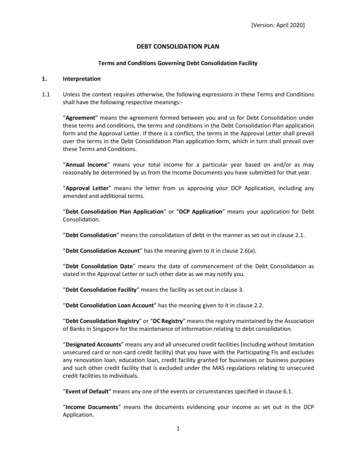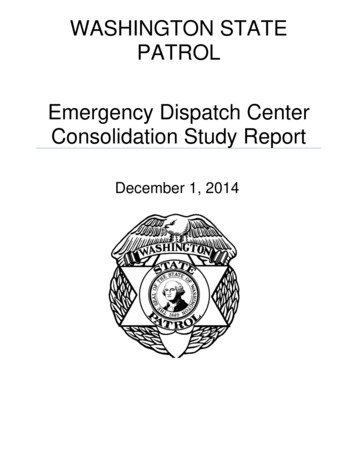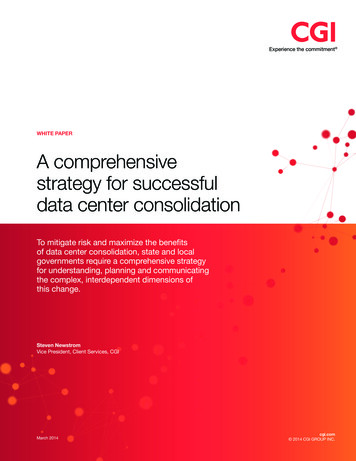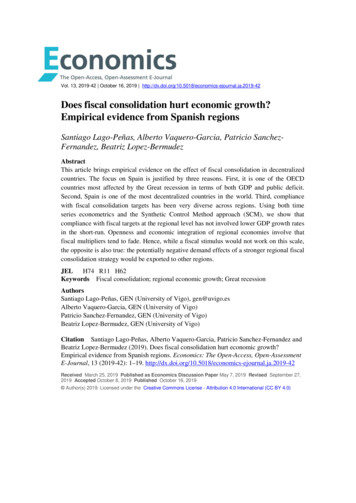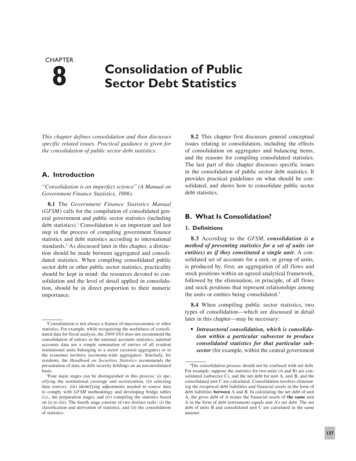
Transcription
Consolidation in the Data CenterDavid Hornby, Global Sales OrganizationKen Pepple, Enterprise ServicesSun BluePrints OnLine—September 2002http://www.sun.com/blueprintsSun Microsystems, Inc.4150 Network CircleSanta Clara, CA 95045 U.S.A.650 960-1300Part No. 817-0181-10Edition: September 2002
Copyright 2002 Sun Microsystems, Inc. 4150 Network Circle, Santa Clara, California 95045 U.S.A. All rights reserved.This product or document is protected by copyright and distributed under licenses restricting its use, copying, distribution, and decompilation. No part of thisproduct or document may be reproduced in any form by any means without prior written authorization of Sun and its licensors, if any. Third-party software,including font technology, is copyrighted and licensed from Sun suppliers.Parts of the product may be derived from Berkeley BSD systems, licensed from the University of California. UNIX is a registered trademark in the UnitedStates and other countries, exclusively licensed through X/Open Company, Ltd.Sun, Sun Microsystems, the Sun logo, Sun BluePrints, Sun StorEdge, and Solaris are trademarks or registered trademarks of Sun Microsystems, Inc. in theUnited States and other countries. All SPARC trademarks are used under license and are trademarks or registered trademarks of SPARC International, Inc. inthe US and other countries. Products bearing SPARC trademarks are based upon an architecture developed by Sun Microsystems, Inc.The OPEN LOOK and Sun Graphical User Interface was developed by Sun Microsystems, Inc. for its users and licensees. Sun acknowledges the pioneeringefforts of Xerox in researching and developing the concept of visual or graphical user interfaces for the computer industry. Sun holds a non-exclusive licensefrom Xerox to the Xerox Graphical User Interface, which license also covers Sun’s licensees who implement OPEN LOOK GUIs and otherwise comply withSun’s written license agreements.RESTRICTED RIGHTS: Use, duplication, or disclosure by the U.S. Government is subject to restrictions of FAR 52.227-14(g)(2)(6/87) and FAR52.227-19(6/87), or DFAR 252.227-7015(b)(6/95) and DFAR 227.7202-3(a).DOCUMENTATION IS PROVIDED “AS IS” AND ALL EXPRESS OR IMPLIED CONDITIONS, REPRESENTATIONS AND WARRANTIES,INCLUDING ANY IMPLIED WARRANTY OF MERCHANTABILITY, FITNESS FOR A PARTICULAR PURPOSE OR NON-INFRINGEMENT,ARE DISCLAIMED, EXCEPT TO THE EXTENT THAT SUCH DISCLAIMERS ARE HELD TO BE LEGALLY INVALID.Copyright 2002 Sun Microsystems, Inc., 4150 Network Circle, Santa Clara, Californie 95045 Etats-Unis. Tous droits réservés.Ce produit ou document est protégé par un copyright et distribué avec des licences qui en restreignent l’utilisation, la copie, la distribution, et la décompilation.Aucune partie de ce produit ou document ne peut être reproduite sous aucune forme, par quelque moyen que ce soit, sans l’autorisation préalable et écrite deSun et de ses bailleurs de licence, s’il y en a. Le logiciel détenu par des tiers, et qui comprend la technologie relative aux polices de caractères, est protégé parun copyright et licencié par des fournisseurs de Sun.Des parties de ce produit pourront être dérivées des systèmes Berkeley BSD licenciés par l’Université de Californie. UNIX est une marque enregistree auxEtats-Unis et dans d’autres pays et licenciée exclusivement par X/Open Company Ltd.Sun, Sun Microsystems, le logo Sun, Sun BluePrints, Sun StorEdge, et Solaris sont des marques de fabrique ou des marques déposées, ou marques de service,de Sun Microsystems, Inc. aux Etats-Unis et dans d’autres pays. Toutes les marques SPARC sont utilisées sous licence et sont des marques de fabrique ou desmarques déposées de SPARC International, Inc. aux Etats-Unis et dans d’autres pays. Les produits portant les marques SPARC sont basés sur une architecturedéveloppée par Sun Microsystems, Inc.L’interface d’utilisation graphique OPEN LOOK et Sun a été développée par Sun Microsystems, Inc. pour ses utilisateurs et licenciés. Sun reconnaît lesefforts de pionniers de Xerox pour la recherche et le développement du concept des interfaces d’utilisation visuelle ou graphique pour l’industrie del’informatique. Sun détient une licence non exclusive de Xerox sur l’interface d’utilisation graphique Xerox, cette licence couvrant également les licenciés deSun qui mettent en place l’interface d’utilisation graphique OPEN LOOK et qui en outre se conforment aux licences écrites de Sun.CETTE PUBLICATION EST FOURNIE "EN L’ETAT" ET AUCUNE GARANTIE, EXPRESSE OU IMPLICITE, N’EST ACCORDEE, Y COMPRIS DESGARANTIES CONCERNANT LA VALEUR MARCHANDE, L’APTITUDE DE LA PUBLICATION A REPONDRE A UNE UTILISATIONPARTICULIERE, OU LE FAIT QU’ELLE NE SOIT PAS CONTREFAISANTE DE PRODUIT DE TIERS. CE DENI DE GARANTIE NES’APPLIQUERAIT PAS, DANS LA MESURE OU IL SERAIT TENU JURIDIQUEMENT NUL ET NON AVENU.PleaseRecycle
Types of ConsolidationWhen we started working on consolidation four years ago, the focus was on serverconsolidation; now, the emphasis has changed. When you walk into a data centerand look around, everything you see is a candidate for consolidation. Today,consolidation is about reducing the number of devices you have to manage andreducing the number of ways you use to manage them.With that in mind, this Sun BluePrints OnLine article takes a look at some of theconsolidation opportunities that exist in today’s Information Technology (IT)environment. These include: “Consolidating Servers,” on page 1 “Consolidating Applications,” on page 5 “Consolidating Storage,” on page 8 “Consolidating Shared Services,” on page 11 “Consolidating Networks,” on page 12 “Consolidating Data Centers,” on page 12 “Consolidating People Resources and Processes,” on page 13Consolidating ServersServers are still the primary focal point for consolidation because they are soobvious. Whether you have 100 servers or 5000 servers, you probably have too manyto manage effectively. Today's distributed computing environment lends itself to aproliferation of servers. Reducing and controlling the number of devices to manageand simplifying ways to manage them is the goal of most IT groups.1
Applying Vertical and Horizontal ScalabilityWhen we talk about consolidating servers, we generally refer to scaling themvertically or horizontally. Vertical scalability enables you to reduce the number of servers by consolidatingmultiple applications onto a single server. Horizontal scalability enables you to deal with increased workloads through thereplication of servers and the distribution of workloads across those servers.By thinking of consolidation in these terms, you begin to define the approachrequired by your particular consolidation project. Once you decide whether yourconsolidation project requires horizontal scaling, vertical scaling, or a combination ofthe two, you can further refine your approach by identifying patterns in your serverpopulation. Examples of vertical and horizontal scaling are presented in the SunBluePrints book Consolidation in the Data Center (ISBN #0-13-045495-8).Identifying Patterns in an End-to-EndArchitectureIn the end-to-end architectures that are prevalent today, tiers of servers arespecialized for particular tasks. When you look at consolidating servers, you need tolook for patterns in your server population. When you identify these patterns withintiers, you can start to devise a consolidation strategy. Scalability is the key, here.Because you are expected to deliver predictable service levels in response tounpredictable workloads, it is important that you use the right type of scalability foreach part of a consolidated architecture. The following sections describe commonpatterns in an end-to-end architecture.For consolidation discussions, we generally assume that there are three server types,or tiers: The presentation tier is the closest tier to the end user. The business, or middleware, tier is where applications or middleware run inconjunction with the other tiers. The resource tier is where large, scalable servers run mission-critical applicationsand databases.Although architectures with these characteristics have been around for awhile, mostcorporations still have many servers running monolithic applications. In many cases,these are older servers running mature applications. These servers are generallyexcellent candidates for server and application consolidation.2Types of Consolidation September 2002
DBWebAppXResourceFIGURE 0-1BusinessPresentationEnd-to-End ArchitecturePresentation TierAs you get closer to the Internet and the delivery devices for your applications, themost common techniques for scalability are replication and load balancing across anarray of generally small servers. This is usually referred to as horizontal scalability.On the presentation tier, you usually find several small, one or two processor serversrunning UNIX , Linux, or Microsoft Windows. Because current architectures callfor many small servers in this tier, the opportunities for consolidating to fewerservers are limited. Despite these limitations, there is still ample opportunity toimplement standards and best practices to simplify the management of these serversand to reduce total cost of ownership (TCO).Business TierAfter the presentation tier, you find business tier servers. These generally runapplications or middleware in conjunction with the other tiers. While we used to seeprimarily horizontal scaling in this tier, there is growing interest in reducing thenumber of applications using vertical scalability, as well.Consolidating Servers3
Resource TierThe resource tier is usually thought of as the heart of the data center. It ischaracterized by large, scalable servers that run mission-critical applications anddatabases. We usually find the most interest in vertical scalability and serverconsolidation on this tier.Identifying Types of ConsolidationSome major consulting groups identify different categories of server consolidation.For example, Gartner refers to physical, logical, and rational consolidation groups—categories we define in the following sections. The techniques used to achieve thesespecific types of consolidations are discussed in later chapters.Physical ConsolidationPhysical consolidation involves consolidating data centers and moving servers tofewer physical locations. The theory behind physical consolidation is that by havingservers in fewer physical locations, you can achieve management consistencies andeconomies of scale more easily than you can when your servers are dispersed.Physical consolidations may also enable you to reduce data center real estate costs. Itis generally felt that physical consolidation has the lowest risk, but that it also hasthe lowest payback.Logical ConsolidationLogical consolidation involves implementing standards and best practices acrossyour server population. By doing this, you can realize substantial benefits in theproductivity of your IT staff. They can manage the environment more efficiently andmore effectively. This can often result in lower systems management costs and inlower TCO. Logical consolidation is often implemented with physical consolidationand rationalization.RationalizationRationalization involves the deployment of multiple applications on fewer, largerservers and in fewer instances of the operating system (OS). Because TCO reductionis closely tied to the number of instances of an OS you manage, reducing the numberis the best way to reduce TCO. While rationalization is the riskiest form of serverconsolidation, it offers the biggest TCO reduction and return on investment (ROI).4Types of Consolidation September 2002
Because of its potential to reduce TCO and increase ROI, we find that most of ourcustomers find rationalization to be the most attractive method for consolidation,despite its higher risks. During a recent web seminar on consolidation, we polledover 300 attendees on whether their main interest was in physical consolidation,logical consolidation, or rationalization. Over 85 percent said their primary interestwas in rationalization.Consolidating ApplicationsUnderstanding which server resources applications use and understanding usagepatterns is essential to the process of consolidating servers. This process is explainedin detail in the chapters about assessment and architecture.Everywhere we go to talk about consolidation, people always ask which applicationsthey should or should not consolidate. There is no easy answer to this question, andyou need to evaluate each application individually. The people who know theapplications best are the developers, database administrators, and systemadministrators who take care of them on a daily basis. Talking with these peopleusually identifies good and bad consolidation candidates rather quickly.Eliminating Consolidation CandidatesWhile it is not easy to make specific recommendations about which applications aregood consolidation candidates, there are some general guidelines you can follow toeliminate candidates from consolidation.First and foremost, consider eliminating all servers and storage that are deliberatelyisolated for other servers. This includes: FirewallsIntrusions detection serversSensitive databasesGeographically separated serversIsolation and separation are vital attributes of many security-related servers. Unlessyou are specifically targeting these machines, they are probably too complex toconsolidate without a complete reevaluation of the security architecture. After youhave consolidated the rest of your environment, you can come back and look foropportunities for security consolidations. The same is true for servers or storage thatare geographically separated. For instance, if you have separated servers forredundancy or wide area network (WAN) reasons, it hardly makes sense to try toconsolidate these together.Consolidating Applications5
Third-party applications developed and sold by independent software vendors(ISVs) may be problematic as consolidation candidates. In many cases, ISVs specifythat their applications run in standalone mode on their own servers. If this is notdone, they usually do not provide support for the application. Make sure you checkwith your vendors for their support requirements.Other applications that do not qualify for consolidation include those that lock upsystem resources such as physical memory. If you aren't sure about an application'ssuitability for consolidation in this respect, make sure you analyze it with aperformance tool such as TeamQuest or BMC’s Patrol-Perform and Predict.Applying Backward and Forward ConsolidationStrategiesWhen most people begin their consolidation efforts, they often focus on existingapplications. This process is known as a backward consolidation. In many cases,these consolidations are hugely successful. In others, organizational issues preventthem from achieving their goals. There is no doubt that some of the largest and mostsuccessful consolidations we have seen have been backward consolidations.To avoid future server sprawl, it is also important to begin to develop newapplications in a consolidated environment, referred to as forward consolidation. It'sinteresting to note that applications that are developed in a consolidatedenvironment usually behave with each other, and can be moved into production in aconsolidated environment.Consolidating Application SetsWhen you analyze a group of servers for consolidation, it is important to identifythe applications that run on them. It is equally important to identify the servers andapplications with which the consolidation candidates interact. It's very common tofind groups of applications that receive data from other applications or that supplydata to other applications. Because these applications process informationsequentially, they are often excellent candidates for consolidation. These applicationsets don't usually compete for the same resources at the same time, and when yougroup them within a single instance of the OS, you often find that they performbetter because of intra-domain communications. A decrease in network traffic isoften a side benefit of consolidating application sets.When deciding which application sets to consolidate, we generally categorize themas being tightly coupled or loosely coupled. In tightly coupled application sets,applications actively interact with each other. In loosely coupled sets, a group ofapplications acquire and process data and then pass them on to the next server.6Types of Consolidation September 2002
As an example of a successful consolidation of tightly coupled applications, considera situation where a customer gathered home-grown Enterprise Resource Planningapplications, Tuxedo messaging, and an Oracle database server and moved theminto a single instance of the OS. The results were extremely successful. Applicationthroughput increased, and network usage decreased. From a scalability viewpoint,the transaction volume of the application set increased from roughly 40,000 salesorder lines per day two years ago to over 400,000 sales order lines per day. This wasobviously a successful consolidation and a successful application of verticalscalability.As an example of a loosely coupled application set, consider a situation where aserver runs an online transaction processing (OLTP) application during the day, thenat night, passes the transaction information to a batch server for further processingand reporting. The batch server would then update a data warehouse server, whichwould, in turn, update multiple data mart servers. Each server depends on another,but not simultaneously.Consolidating Multiple Database InstancesA very common example of server and application consolidation is to put multipleinstances of a database in a single instance of the OS. This is a very common tacticwith most major databases. It's important to note that you don't want to mix thesetwo databases on the same instance of the OS; doing so may cause fatal applicationconflicts.The success of this consolidation strategy depends heavily on developmentstandards and practices. Where strict naming conventions are followed and eachinstance of the database is unique, consolidations are successful. However, on anoccasion when we worked with a customer who wrote multiple Oracle applicationsand chose to use default naming conventions, multiple conflicts resulted betweendatabase instances. Obviously, this consolidation was not successful.Consolidating Similar WorkloadsAnother consolidation technique that some consultants recommend is to consolidatesimilar workloads with like resource usage and time scheduling. If you do this, youneed to understand the application’s resource usage very clearly. When using thisconsolidation technique, the key to success is that you must offset the timing ofresource usage for each workload. Otherwise, you simply end up with overlappingpeaks and valleys of resource usage.Consolidating Applications7
Consolidating StorageToday, there is as much interest in storage consolidation as there is in serverconsolidation. As we said earlier, every new server you deploy results in morestorage. In many cases, the cost of storage for a server exceeds the cost of the server,and although the server may not grow very much, the amount of storage requiredfor an application will grow indefinitely.When you look at application sets, you find a lot of data replication because multipleapplications look at the same data. For example, if you have an OLTP server, a batchserver, a data warehouse server, and four data mart servers, you may have sevencopies of a particular dataset such as a customer master file. While, in theory, allseven copies are identical, because different developers probably created theirapplications, it is likely that there will be differences in each copy of the data. Thissituation has the potential to create a situation where reports run on the “same”data, yet yield different results.As with servers, the goals in storage consolidation are to reduce complexity, increaseutilization, and reduce TCO. These goals can be achieved through a variety ofconsolidation techniques. The ultimate goal is data sharing among applications.Unfortunately, this often requires redesigning and redeveloping applications, so it isa long-term goal, at least for backward consolidation. In a forward consolidation,data sharing should absolutely be a goal.Other benefits of storage consolidation include: Easier backup and recoveryIncreased availabilityImproved scalabilityStorage resource poolingWhen undertaking a storage consolidation effort, it is critical that you understandhow disk space is utilized. While most of our customers can't tell us exactly whattheir current disk space utilization rates are, many companies we have surveyedestimate a rate of 40 percent, or less. For companies that have tried to accuratelyassess disk utilization, complexity often hinders their efforts. For example, onecompany we visited started counting storage, but stopped at 110 terabytes afterrealizing that they just couldn't count it all. When we evaluated their diskutilization, we found they were utilizing only 20 percent of their available storage.There are several types of storage consolidation available today. The followingsections describe the three most common types we see.8Types of Consolidation September 2002
Consolidating Servers and Their AssociatedStorageWith every server consolidation, there is an accompanying storage consolidation. Asyou move multiple applications to a single instance of the OS, you must also movetheir storage, as shown in the following graphic. In theory, once you have moved thestorage, data will be available to any of the applications. This is the most primitiveform of storage consolidation.FIGURE 0-2Consolidating Direct-Attached StorageConsolidating Storage9
Connecting Heterogeneous Environments to aSingle Storage ComponentMany of our customers have heterogeneous IT environments. They run servers andOSes from many vendors, and they want to access data from a variety of differentservers. With direct-attached storage, this was difficult to do. Now, with productslike the Sun StorEdge 9900 storage array, it is possible to connect the Solaris Operating Environment servers, other UNIX servers, Microsoft Windows NTservers, and mainframe servers to the same storage array. The following graphicdemonstrates this capability.F6800E6500UnixMainframeNTFIGURE 0-3Heterogeneous Environments to Single StorageThis is a very popular type of storage consolidation, especially where there aremultiple mission-critical applications running on servers from a variety of vendors.Consolidating With Storage Area NetworksStorage area networks (SAN) have been the hottest trend in storage architectures forthe last few years. As a technology, the SAN is now mature enough that it can beimplemented using standards and standard configurations. As shown in thefollowing graphic, SAN technology inserts a network, or fabric, of switching devices10Types of Consolidation September 2002
between servers and storage that enable any server or application to access anystorage connected to it. The fabric can then be configured to allow various servers toaccess various storage.Storage NetworkSun Fire15KFIGURE 0-4Sun FireV880Sun Fire12KSun Fire3800RSun Fire6800Storage Area Network (SAN) ConfigurationAnother hot storage technology is network attached storage (NAS). This technologyallows servers and clients to utilize storage directly over the network using commonnetworking protocols like network file system (NFS) and Server Message Block(SMB). Although not used greatly in many server and application consolidationswithin the data center, it is used extensively in file and print consolidations at thedepartment and workgroup level. As the technology matures, expect it to work itselfinto data center consolidations.Consolidating Shared ServicesAnother type of consolidation that is rapidly gaining popularity is middleware orshared services consolidation. Over the last few years, companies have implementedshared services (such as file, print, authentication, and e-mail) in a variety of ways.Business units typically implement their own versions of these services usingsoftware from a variety of vendors; however, when they want to share some of thisinformation, they find that the inconsistencies and incompatibilities among thesevarious architectures increase complexity, thereby increasing cost and making itConsolidating Shared Services11
difficult to share. As a result, we often find that companies want to rebuild theirshared services as web services using a standards-based, unified architecture such asSun Open Net Environment (Sun ONE).A common example of this is the use of directory services. Directory services havebeen implemented over the years using a variety of architectures. Now thatstandards based architectures are available, products like the Sun ONE DirectoryServer, which is based on the Lightweight Directory Access Protocol (LDAP), arebeing used to design and implement corporate-wide directory services. Condensingmultiple, disparate directory architectures into a single, corporate architectureallows corporations to simplify directory maintenance and easily replicate directoryservices, as needed.We expect to see more of this type of consolidation over the next few years.Consolidating NetworksWhen you consolidate servers and applications, network consolidation is usuallyeither a big issue or not an issue at all. When you collapse data centers andconcentrate servers and applications into fewer physical locations, there may be asevere impact on the network. This impact must be evaluated as part of theconsolidation project. You certainly need to ensure that there is sufficient networkbandwidth to handle network traffic to and from the consolidated location.Conversely, when you do a rationalization within a single data center, you often findthat there are no major network changes that need to take place. The overall trafficdoes not increase, since new servers and applications are not being introduced.Further, rationalization may actually decrease network traffic, because applicationsin a single instance of the OS don't need the network to communicate with eachother.Consolidating Data CentersMany organizations are looking to consolidate multiple data centers into one site.These consolidations range from simple city-wide consolidations to complex regionwide consolidations. Most companies are being driven toward data centerconsolidation because of the dramatic drop in the cost of telecommunication widearea network lines, the huge disparity of IT wages between certain regions of the12Types of Consolidation September 2002
world, and the high real estate costs of large cities (especially in New York, London,and Tokyo). For those considering simple local-site consolidations, consolidationoffers cost savings and enables disaster recovery initiatives.If your organization is seriously looking to consolidate a data center, carefullyconsider the goals for consolidation. Shutting a data center is a huge task, and beforeyou even start down the path, it is vital that you can articulate and defend yourreasons for doing it. Further, once a data center is shut down, the costs of reopeningit can be enormous. From there, data center consolidations are similar to other typesof consolidation, except that assessment (especially application, networking, andphysical planning) and implementation become much more complex.Consolidating People Resources andProcessesIn any consolidation project, you must not neglect the people and processes you useto manage your environment. Time after time, when we work with clients who haveboth mainframe and distributed-computing environments, we find that themainframe side of the house runs smoothly and problem free, while the distributedcomputing side of the house is often chaotic, with few developed standards andprocedures. The problems that result from this situation demonstrate the importanceof resolving these people and process issues. While mainframes consistently runwith high availability and high service levels, distributed computing systems oftensuffer from low service levels and low availability.Some consulting groups estimate that only 20 percent of data center availability ishardware or technology related; the other 80 percent is estimated to be directlyrelated to people and process issues. The lesson is that successful consolidationsmust address standards, people, and processes. Without these, availability andservice levels may be compromised.Another benefit of implementing standards and best practices is that you frequentlysee a 10–20 percent reduction in TCO. You may be able to realize these types ofsavings by following the recommendations outlined in the Sun BluePrints bookConsolidation in the Data Center (ISBN #0-13-045495-8).Consolidating People Resources and Processes13
Related ResourcesThis article is an excerpt from the Sun BluePrints book Consolidation in the DataCenter (ISBN #0-13-045495-8). Refer to the book for more information about thetopics presented in this article.About the AuthorsDavid Hornby has been with Sun for five years in Sun Professional Services (Sun PS)and in Sun's Global Sales Organization. While with Sun PS, he specialized in serverconsolidation and data center consulting, helped develop the Sun PS consolidationmethodology, and participated in the sale and implementation of multiple serverconsolidation projects. David currently focuses on consolidation and TCO strategies.Prior to joining Sun, he spent 25 years in IT with an emphasis on providing ITsolutions to business problems. He has over 10 years experience managing ITorganizations at the CIO level.Ken Pepple is an IT Architect in the Sun PS Asia Pacific practice. In this role, Kenassists clients with enterprise computing arch
consolidation project requires horizontal scaling, vertical scaling, or a combination of the two, you can further refine your approach by identifying patterns in your server population. Examples of vertical and horizontal scaling are presented in the Sun BluePrints book Consolidation in the Data Center (ISBN #0-13-045495-8).



